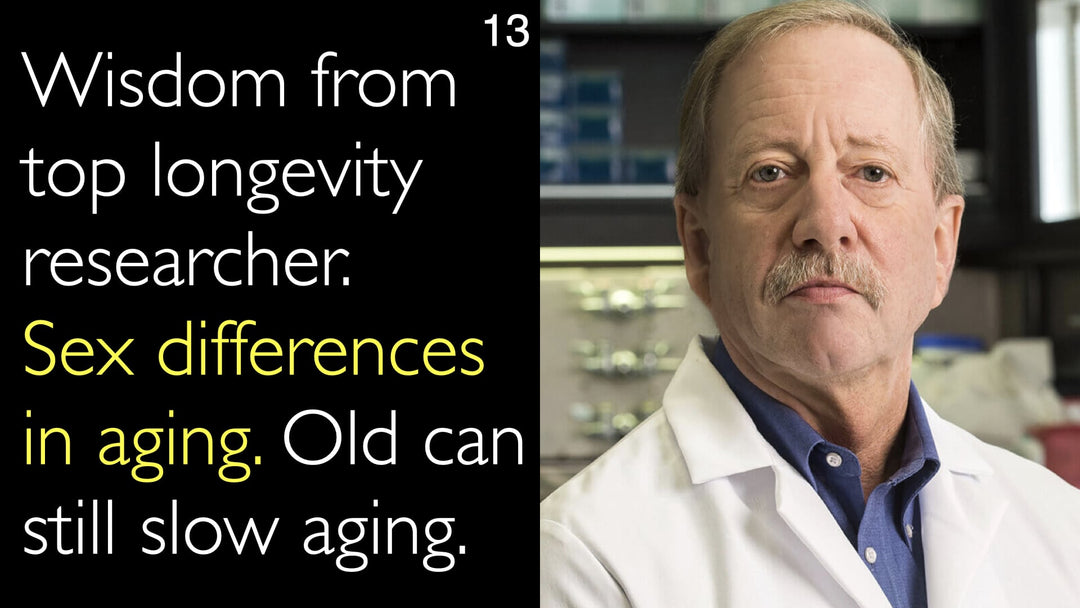But if we step back a little bit, and perhaps can address the methods of modern aging research, because there are several model organisms, as they say, the Security Council of Biology, but again, how is modern aging research is being done, perhaps you can give a high-level overview.
So, I would say, laboratory mice are still probably the gold standard for preclinical studies. Dr. Matt Kaeberlein, PhD. Dr. Anton Titov, MD. That's in part because, you know, those, that's the model organism that has been used most extends extensively over the last, you know, several decades, and the availability of laboratory mice. So, you know, one of the really important, I think, changes over the last five years or ten years has been the commercial availability of aged rodents for experimental studies. You know, it used to be hard to do aging studies, lifespan and healthspan in mice, because you had to start three years ago, you know, to get your mice old enough to do the experiments or two years. Now, you can just buy aged mice from jacks, so that has had a big impact on facilitating, you know, an expansion of aging studies in preclinical models. Then, you know, another consequence of that, though, is that even more people are using mice, perhaps at the expense of exploring aging and other model systems. Dr. Matt Kaeberlein, PhD. Dr. Anton Titov, MD. So, you know, the classic animal models for aging research are budding yeast, the nematode worm, C. elegans, fruit flies, and mice. I would still say 90% of the preclinical work in the field is done in those models. killifish is emerging as a really interesting new vertebrate model. But it's still a relatively small number of animals using killifish. You know, and then there are some of these other more esoteric animal models like the naked mole-rat that a couple of people have been studying for many years. But again, that's a real minority of the field, studying aging in these very long-lived animal models, because it's hard to do experiments in an animal model that lives 30 years, right. That's the brilliance of something like C. elegans, that ages and dies in three weeks. You can do 1000s of experiments in a reasonable amount of time. You just can't do that, even in mice, and certainly not in, you know, a naked mole-rat that lives 30 or 40 years. So it's a balancing act. The other animal model that might be worth there is two that I think might be worth mentioning. One is the marmoset, which is a non-human primate. Dr. Matt Kaeberlein, PhD. Dr. Anton Titov, MD. Dr. Matt Kaeberlein, PhD. Dr. Anton Titov, MD. There are a few labs studying aging in the marmoset. One of the advantages of the marmoset over sort of larger non-human primates is that they have a lifespan, you know, that is in the range of 10 to 20 years. One of the disadvantages of the marmoset is we don't know what its lifespan in captivity is. So I think I think that's been a challenge for some of the people working with the marmosets is they thought that the marmosets were only going to live ten years. But it turns out they probably live longer than that in captivity. So so we'll see whether the marmoset emerges as a, useful non-human primate model. And then, of course, the animal that I am particularly interested in and excited about understanding the biology of aging is the companion dog or the pet dog. You know, pet dogs are really interesting. Animals in which to study biological aging for a variety of reasons. Two of the big ones are they age rapidly. So you know, everybody's familiar with the idea that you know, one human year is about seven dog years. And all that means is dog's age about seven times faster than people do. That, of course, is not a true biological equivalence, but it's pretty close. So that means you can do studies to try to understand what are the most important genetic and environmental determinants of healthy aging in pet dogs in a reasonable timeframe. Another feature of dogs, though, that I think is pet dogs, in particular, is really important to appreciate as they share the human environment. And, you know, we've already talked a little bit about how most of the studies in mice are done, you know, in very well controlled pathogen-free facilities, you know, not much variation and environment. Dogs experience almost all of the environmental variation that people do. So from the perspective of trying to understand The role of environmental variation in biological aging, I think companion dogs are a particularly powerful animal in which to study that, you know. Then maybe most importantly, people love their dogs. I, you know, I'm a dog person. I love my dog. And so I think if we're able to both understand the aging process in dogs and potentially modify that process to give pet dogs extra years of healthy lifespan,
you know, that has a significant intrinsic value in and of itself, for the quality of life, both for the dog and for the human. And so for those reasons, I, you know, I kind of feel like companion dogs provide a lot of value for the field in terms of understanding the biology of aging. And so, you know, we're actively trying to build the infrastructure that will allow the field to be able to use the companion dog to study the biology of aging. Dr. Matt Kaeberlein, PhD. Dr. Anton Titov, MD.
So this is, yeah, dogs are very interesting. But considering the importance of diet eight no in disease in humans in every interaction, it seems like the companion dogs diet, at least in the Western world, is quite well controlled, standardized and optimized. And human food is not advised for dogs. Obviously, in other parts of the world, it's significantly different. How do you see that comparison? That sort of diet factor being removed from the environment essentially?
Yeah, it's a good question. So a couple of things, I would say, I think you're right, at least in the Western world, most companion dogs don't eat a diet that is comparable to the human diet, at least in terms of the specific, you know, the composition of the foods consumed. There are, of course, you know, many, maybe most companion dogs do get some human food from time to time. Dr. Matt Kaeberlein, PhD. Dr. Anton Titov, MD. But the other point I would make is, you know, you said that the diet is well controlled and optimized, and companion dogs and I would say, that's not the case. You know, there are various diets that people will give to their pets. You know, even just from the major brands of dog food, there are, I don't know, dozens of different, you know, formulations, you know, lamb and rice, chicken, beef kibble, wet food, prescription diets, fish oils. So there's a whole, there's a lot of variation actually, in the diet that companion dogs are given, including, you know, a lot of people now that feed their dogs, a raw food diet, so, so I would say, they don't eat the same diversity of foods that people do. But there is a maybe comparable diversity of foods that companion dogs eat. And so I think we can certainly if you can get a large enough population of companion dogs, and, you know, understand what diet those dogs are receiving, there's the potential actually to do some correlative sorts of analyses to try to understand does composition of the diet have an impact on health outcomes during aging? And so in that way, you know, I don't think anyone would argue dogs are a perfect model for human aging. Dr. Matt Kaeberlein, PhD. Dr. Anton Titov, MD. The only perfect model for human aging is going to be humans. But in that way, I think still, you know, it's a step up from the laboratory rodents, which are, you know, almost exclusively fed a very refined diet with a very controlled amount of diet, you know, suitable for the study. So, I think I think companion dogs can capture dietary diversity, to a pretty good extent, that which may give us some insights into the role of diet in healthy aging. And I think the other thing you can look out for companion dogs is how much are they eating? So caloric intake? And how, how frequently are they eating? How often are the dogs fed? And, you know, we analyzed feeding frequency with health outcomes during aging recently as part of the dog aging project. So one component of the dog aging project is a longitudinal study of aging, where we now have enrolled about 34,000 dogs into the dog aging project pack, which is the sort of foundational component of the longitudinal study. And so, for dogs to be enrolled in the pack, the owners complete a fairly extensive survey that captures their health history, their home environment, food consumption patterns, things like that. So sort of comprehensive health and life experiences survey. And so one of the questions on that survey is how frequently do you feed your dog? And not surprisingly, some people feed their dogs, you know, what we call ad libitum. So the dog always has access to food. Some people feed their dogs three times a day, some people two times a day, some people one time a day, so the most common feeding frequency for pet dogs, at least in the United States, appears to be twice a day. I think it was more than maybe half of the owners in our cohort fed their dogs twice a day, but a significant fraction fed their dogs once a day. And so we just asked a very simple question, which is, you know, if you look at the dogs fed once a day, and you look at the dogs fed more than once a day, you just put them into those two buckets. Dr. Matt Kaeberlein, PhD. Dr. Anton Titov, MD. And then you ask, what is the frequency of diagnosing a given age-related disease in those two groups? You know, what was pretty striking was that in the dogs that are fed once a day, they had lower frequencies of diagnoses for, I think, ten different categories of age-related functional or disease outcomes. And in six of those categories, the effects were big and statistically significant. So, you know, it's a strong signal that I think is suggestive. You can certainly say there's a correlation between many age-related health outcomes, and feeding frequency in dogs doesn't prove causality. And you can think of some potential explanations like maybe dogs fed once a day are less likely to be obese, that could be underlying this. Dr. Matt Kaeberlein, PhD. Dr. Anton Titov, MD. But I think it illustrates the power of having a large number of companion dogs, where you've got data on, there's something very simple like feeding frequency and disease diagnoses. So you can start to ask these big picture questions, which then are hypothesis-generating, and potentially allow you to ask more mechanistic questions in the future? So, so So again, that was sort of a long-winded answer to your question, but I think that dogs can tell us something about the impact of diet nutrition on aging.







